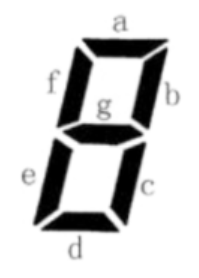问题描述
小蓝要用七段码数码管来表示一种特殊的文字。
上图给出了七段码数码管的一个图示,数码管中一共有 7 段可以发光的二极管,分别标记为 a, b, c, d, e, f, g。
小蓝要选择一部分二极管(至少要有一个)发光来表达字符。
在设计字符的表达时,要求所有发光的二极管是连成一片的。
例如:b 发光,其他二极管不发光可以用来表达一种字符。
例如:c 发光,其他二极管不发光可以用来表达一种字符。
这种方案与上一行的方案可以用来表示不同的字符,尽管看上去比较相似。
例如:a, b, c, d, e 发光,f, g 不发光可以用来表达一种字符。
例如:b, f 发光,其他二极管不发光则不能用来表达一种字符,因为发光的二极管没有连成一片。
请问,小蓝可以用七段码数码管表达多少种不同的字符?

思路
abcdefg分别对应0123456
利用DFS回溯得到所有可能性
并查集判断是否连通
连通条件:
并查集的连通分量个数应该等于7个数字中没有选中的数字+1;比如选中了0124即abce,那么没有选中的个数为3,并查集的连通分量个数为5(012为一个连通分量,不出现的各自为一个连通分量,4没有与其他合并也为一个连通分量);5不等于3+1,那么便是不连通的。
link函数含义:
先把当前要判断的选中灯的转换为set
遍历选中的灯其中每一个
如果是0,且set中有1或者5,合并;
如果是1,且set中有2或者6,合并;
如果是2,且set中有3或者6,合并;
如果是3,且set中有4,合并;
如果是4,且set中有5或者6,合并;
如果是5,且set中有6,合并;
由于取得的灯都是增序,只需要合并它之后的就可以
并查集模板
class unionfind {
int[] parent;
int[] size;
int count;
public unionfind(int n) {
parent = new int[n];
size = new int[n];
count = n;
for (int i = 0; i < n; i++) {
parent[i] = i;
size[i] = 1;
}
}
public int root(int x) {
while (x != parent[x]) {
parent[x] = parent[parent[x]];
x = parent[x];
}
return x;
}
//合并
public void union(int x, int y) {
int rootX = root(x);
int rootY = root(y);
if (rootX == rootY)
return;
if (size[rootX] < size[rootY]) {
parent[rootX] = rootY;
size[rootY] += size[rootX];
} else {
parent[rootY] = rootX;
size[rootX] += size[rootY];
}
count--;
}
}
DFS回溯求得所有子序列模板
//deque用于保存子序列 这里可以改成各种需要回溯的数据结构
public void dfs(List<List<Integer>> list,ArrayDeque<Integer> deque,int begin)
{
if(//终止条件)
{
return;
}
list.add(new ArrayList(deque));//保存数据
for (; begin<//数组长度; begin++) {
deque.addLast(begin);
dfs(list,deque,begin+1);
deque.pollLast();
}
}
二者结合
class unionfind {
int[] parent;
int[] size;
int count;
public unionfind(int n) {
parent = new int[n];
size = new int[n];
count = n;
for (int i = 0; i < n; i++) {
parent[i] = i;
size[i] = 1;
}
}
public int root(int x) {
while (x != parent[x]) {
parent[x] = parent[parent[x]];
x = parent[x];
}
return x;
}
public void union(int x, int y) {
int rootX = root(x);
int rootY = root(y);
if (rootX == rootY)
return;
if (size[rootX] < size[rootY]) {
parent[rootX] = rootY;
size[rootY] += size[rootX];
} else {
parent[rootY] = rootX;
size[rootX] += size[rootY];
}
count--;
}
}
public class Main {
public static void main(String[] args) {
List<List<Integer>> numlist = new ArrayList<>();
ArrayDeque<Integer> deque = new ArrayDeque();
dfs(numlist,deque,0);
List<List<Integer>> listres = new ArrayList();
for (int i = 1; i < numlist.size(); i++) {
List<Integer> getlist = numlist.get(i);
if(link(getlist))
{
listres.add(getlist);
}
}
System.out.println(listres.size());
}
public static void dfs(List<List<Integer>> numlist,ArrayDeque<Integer> deque,int begin)
{
if(begin>7)
{
return;
}
numlist.add(new ArrayList(deque));
for (; begin <7; begin++) {
deque.addLast(begin);
dfs(numlist,deque,begin+1);
deque.pollLast();
}
}
public static boolean link(List<Integer> getlist) {
Set<Integer> set = new HashSet(getlist);
unionfind uf = new unionfind(7);
for (int i = 0; i < getlist.size(); i++) {
if(getlist.get(i)==0)
{
if(set.contains(1))
{
uf.union(0, 1);
}
if(set.contains(5))
{
uf.union(0,5);
}
}
if(getlist.get(i)==1)
{
if(set.contains(2))
{
uf.union(1, 2);
}
if(set.contains(6))
{
uf.union(1,6);
}
}
if(getlist.get(i)==2)
{
if(set.contains(3))
{
uf.union(2, 3);
}
if(set.contains(6))
{
uf.union(2,6);
}
}
if(getlist.get(i)==3)
{
if(set.contains(4))
{
uf.union(3, 4);
}
}
if(getlist.get(i)==4)
{
if(set.contains(5))
{
uf.union(4, 5);
}
if(set.contains(6))
{
uf.union(4,6);
}
}
if(getlist.get(i)==5)
{
if(set.contains(6))
{
uf.union(5, 6);
}
}
}
return 7-getlist.size()+1==uf.count;
}
}
版权声明:本文为weixin_45289678原创文章,遵循CC 4.0 BY-SA版权协议,转载请附上原文出处链接和本声明。